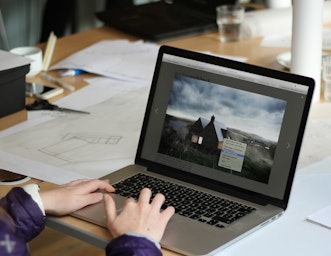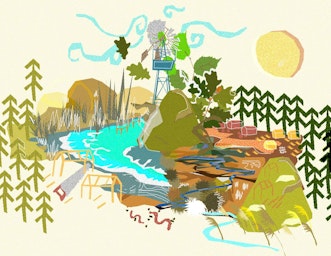
Programme Leader Dr Carl Meddings gives an insight into what final-year students on CAT’s professionally accredited Masters in Sustainable Architecture (ARB Part 2) have been up to over the last few years.
The M.Arch Sustainable Architecture course embodies CAT’s mission to explore solutions to the climate and nature crises by pushing the boundaries of architectural design and sustainability.
Our students are on a quest to bring about change, to realise better ways of being in the world, and to work together to challenge the orthodoxy of the profession (and beyond). They are learning how to do architecture in a way that is respectful, inclusive, caring, nurturing and responsive to people, place and the planet.
Our ethos on the course is to explore the issues we need to engage with to develop humane, sustainable and responsible architecture. The projects below provide you with a snapshot of the journey the students have been on in recent years.
What is M.Arch?
CAT provides postgraduate-level education through the Graduate School of the Environment on a wide range of topics related to sustainability, including a Masters in Sustainable Architecture (ARB Part 2) for students training to be architects. This is the only rural-based and sustainability-focused architecture course in the UK.
We break the mould of traditional architectural education, putting several key themes at the heart of how we teach.
- We are a community of learners, with students, tutors and professors learning from each other.
- We provide an aesthetic education – materials, making and craft sit at the heart of what we do.
- We define sustainable architecture by doing architecture differently, acknowledging the impact of humanity on our planet and the need to act now.
Community consultation in Conwy and Llandudno Junction – October 2021
The first project students take on includes a thorough analysis of a place. This cohort conducted a community consultation exercise in Conwy and Llandudno Junction in North Wales. They carried out detailed group analytical studies into a wide range of factors that impact on life in the area. The findings of these studies were shared by the year group and helped to underpin detailed consultation exercises.
The students spent a full day in key locations in both towns exploring ways to engage local people of all ages to share their thoughts on the issues they face in their daily lives. Two consultation stalls were set up at Llandudno Junction and Lancaster Square (in Conwy) railway stations to engage as many people as possible and understand the perspective of residents and visitors.
Scotland trip – September 2022
For their yearly field-study visit, the students travelled to Scotland. Based in Glasgow, they visited architectural projects and offices both in the city and further afield. The study trip is designed to form part of their professional studies in architecture, to help deepen their understanding of the profession, its wider context and complex history. All this helps broaden our students’ horizons as they seek to explore possibilities and set the directions for their professional journeys.
Sustainable Materials Week – May 2023
Each year, Materials Week sees M.Arch students team up with students from CAT’s MSc programmes to get their hands dirty in a series of workshops on natural materials. They learn from experts on construction techniques using earth, straw, hemp, lime and timber.
In 2023 workshop sessions included:
- Strawbale construction with John Butler and Joe Duirwyn
- Rammed earth and cob with Maria Sanchez and Dieter Brandstätter
- Lime with Stafford Holmes and Lynn Mathias
- Timber milling and structural analysis with Ivor Davies, Tim Coleridge and Julian Russell
- Fibre and binders (including hemp lime) with Pat Borer and Gwyn Stacey
Final design projects 2023-24
The final design project provides students with the opportunity to develop a design concept relating to a subject and/or location that resonates with them. These projects follow the same stages as real-life architectural projects, giving students invaluable experience of the different aspects of design.
Giada Gonzalez –Highgate Ecology Centre
Urban green spaces, small or large, play a significant role in enabling human interactions with nature while providing habitats for wildlife. Human-to-nature relationships are crucial for healthy development, as well as physical and mental wellbeing. The Highgate Ecology Centre aims to provide a coexistence space, where tools to increase biodiversity in densely populated areas can be researched, taught and experienced. Additionally, the centre acts as a catalyst for change, empowering its users with the knowledge and tools to make a positive impact.
Jemma Ho – Wood Culture Wales
To grow our planet and people resiliently together requires inclusive, holistic and regenerative actions. Wood Culture Wales aims to better sustain and develop the use of homegrown timber to address the climate and nature emergencies regeneratively. It is a public centre that provides experimental spaces from seed to mill to product. It acts to catalyse various activities across the production of timber that will reduce our reliance on imports, boost skills, promote economic growth, and develop a truly sustainable future for Welsh timber production.
Felicity Davies – Mental Health Recovery Centre
The number of people experiencing mental health conditions is growing and recovery can be a difficult journey. Merging a need for supportive mental health spaces with more active spaces for various arts and trades, the site helps people to participate in activities that go beyond oneself. The proposal seeks to engage the local community and wider public. In thisway, it is hoped the stigma surrounding mental health can be broken.
About the author
Carl is the Programme Leader for CAT’s MArch: Sustainable Architecture course. He is an architect and educator with a passion for educating architects in a rapidly changing cultural and professional environment. He has taught at all levels from first-year undergraduate to final year master’s and beyond. Carl is an active RIBA member serving on Validation Boards, the New Courses Group and the Membership Eligibility Assessment Panel.
- Graduate School
- Masters in Architecture
- News Feed
Related Topics

STUDENT PROJECTS
EMAIL SIGN UP
Keep up to date with all the latest activities, events and online resources by signing up to our emails and following us on social media. And if you'd like to get involved and support our work, we'd love to welcome you as a CAT member.




